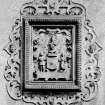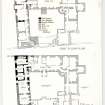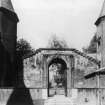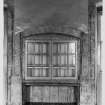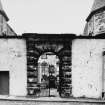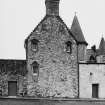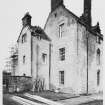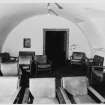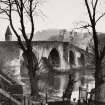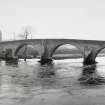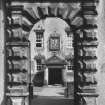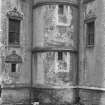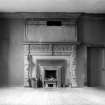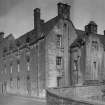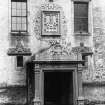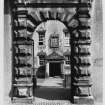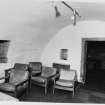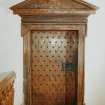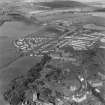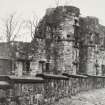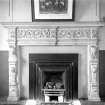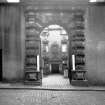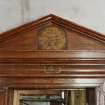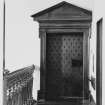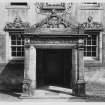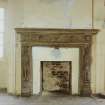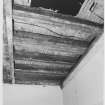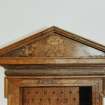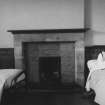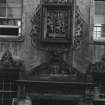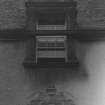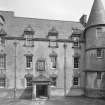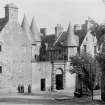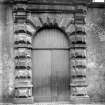Stirling, Castle Wynd, Argyll's Lodging
Hospital (First World War), Hospital (19th Century), Town House (17th Century), Youth Hostel (20th Century)
Site Name Stirling, Castle Wynd, Argyll's Lodging
Classification Hospital (First World War), Hospital (19th Century), Town House (17th Century), Youth Hostel (20th Century)
Alternative Name(s) Argyll Lodging; Argyle Lodging; Military Hospital; Argyll's Ludging
Canmore ID 46197
Site Number NS79SE 21
NGR NS 79261 93808
Datum OSGB36 - NGR
Permalink http://canmore.org.uk/site/46197
First 100 images shown. See the Collections panel (below) for a link to all digital images.
- Council Stirling
- Parish Stirling
- Former Region Central
- Former District Stirling
- Former County Stirlingshire
NS79SE 21 79261 93808
(NS 7925 9381) Argyll's Lodging (NR)
OS 6" map, (1958).
For Stirling Castle, see NS79SE 6.00.
Argyll's Lodging is the most important surviving town-house of its period in Scotland. The building is grouped round three sides of an irregular courtyard; it is not all of the same date, rather, a house of moderate size has been altered and added to to produce the present mansion. The original house may be ascribed to the 16th century, and various additions were made in the 17th century. In 1666 the site was purchased by Archibald, 9th Earl of Argyll. It was sold by the 4th Duke of Argyll in 1764, and is now Crown property, in use as a military hospital.
RCAHMS 1963, visited 1954 and 1958.
The building bears the dates 1632 and 1674 inscribed upon it. It is in use as a youth hostel and is in good condition.
Visited by OS(JP) 11 December 1973.
NS 792 938 A watching brief was carried out late in 1994 at the Argyll's Lodging, Stirling, during renovation work. A trench 0.4m wide was opened under archaeological supervision. Several mid-20th century structures were recorded, along with some structures of indeterminate but possibly earlier date. The latter were not excavated. No finds were recovered.
Sponsor: Historic Scotland.
G Ewart and A Dunn 1995.
NS 792 938 During August 1995, prior to the installation of surfaces in parts of the N and E range ground floor chambers (Lower Hall, Corridor, Kitchen and Cellar), modern underfloor deposits and late medieval occupation debris were removed to an average depth of 350mm.
Within the Lower Hall, the construction cut for the 17th century Town-House was found to truncate a complex cultivated soil deposit, associated with the primary tower-house occupation (early 16th century). This soil horizon contained an abundance of 14th-15th century pottery. Against this surface, and on exposed natural bedrock and boulder clay was found evidence of timber joists for the 17th century floor and the contemporary staircase. A modern drain truncated the floor level, running across the chamber from the E door to the W.
In the Corridor between the Lower Hall and the Cellar, evidence was found of the timber floor continuing from the Lower Hall, dating c1630, thereby predating the present wall configuration. In the Kitchen, the fireplace and original floor were overlain by a complex series of coal and ash deposits, most of which reflect the 19th and 20th century occupation of the house. The floor comprised artificially levelled bedrock, and contained 2 rock-cut features of uncertain date, probably relating to the 16th century occupation of the site.
In the Cellar between the corridor and the Kitchen, modern debris was excavated to the required depth, or to bedrock.
Sponsor: Historic Scotland.
G Ewart and P Sharman 1995
During the current refurbishment of Argyll?s Lodging in Stirling, Kirkdale Archaeology was contracted to excavate in the easternmost ground floor room in the 1674 part of the S range, and to monitor external ground clearance operations to the W of this room, in the area of the demolished S wing, during March 1996. The excavations revealed the survival of a medieval and early post-medieval cultivated soil and evidence for the various uses of the room whilst the building was a military hospital. The external ground clearance uncovered the remains of the 1674 foundations of the N part of the S wing, although no occupation levels were disturbed by the work.
Further archaeological monitoring was undertaken in June 1996 during ground-breaking work in the gardens to the S and E, as well as in the street outside, to the W of the demolished S wing. A probable post-medieval garden soil was revealed along with a substantial E-W wall in the gardens, and evidence for the former W wall of the 1674 wing was uncovered, overlying a midden deposit containing leather offcuts. The latter was seen to overlay a possible earlier cobbled street surface. Features revealed during plaster removal in the house were also recorded.
Sponsor: Historic Scotland
G Ewart, P Sharman and D Murray, 1996
NS 7925 9381 An archaeological watching brief was undertaken during the excavation of two small inspection holes being opened up at the S end of the E wall of the garden attached to the S side of Argyll's Lodging (Ewart, Sharman and Murray 1996). The core of the building is thought to be 16th century in date, with the bulk of it being built during the 17th century, with the late 17th-century S wing being demolished, apart from the street frontage, during the 1860s. The wall against which the trenches were excavated, which forms part of the terrace for a garden, was bulging at its base and it was hoped that these excavations might shed light on this problem.
A 19th-century imported garden soil containing green-glazed pottery, but also some white china and clay pipe, overlay a deposit of mostly whin rubble and mortar, which was not bottomed. This seems most likely to derive from the 1860s demolition of the S wing of Argyll's Lodging, and had been cut by a trench running N-S against the E wall. This was shown to contain the upper part of this wall, which must be a rebuild on top of an earlier wall, and which bottomed some 800mm below the modern ground level. Beneath this the wall stepped in dramatically, and excavations were ceased.
Sponsor: Historic Scotland
D Murray 1998
NMRS REFERENCE:
Dates 1632-44 Sir Anthony Alexander. Architect. for his father Sir. Wm.
EXTERNAL REFERENCE:
Scottish Record Office
Letter concerning 'wastes and ruinous houses'.
The Duke of Argyll's property is in a ruinous state. Consequently those
that own the tenements opposite it both in Castle Wynd and the High Street
will not repair or rebuild theirs until the Duke declines to rebuild, he should have his
property taken down and levelled to make 'a terras from Mar's house to the
Cross, with a handsome parapet breast high, next the street coped with hewn
stone.'
Letter from -to cousin of John 2nd Duke of Argyll.
1740 GD 189/2/172
Jottings [in Argyll's hand] of charges for mason work.
1675 GD 90/2/100
SCOTTISH NATIONAL PORTRAIT GALLERY
'Country Life', March 13th 1909 - article and photographs
'Country Life', Dec. 5th 1947 - article and photographs
Publication Account (1978)
The Argyll's Ludging, recently converted into a Youth Hostel, has been described as one of the most important surviving townhouses of its period. On plan, the buildings are grouped around three sides of a courtyard, the fourth side being a screen-wall with an entrance gateway. Although the residence appears to superficially be all of one period, it is the result of several phases of re-building and extension from the late sixteenth century until 1674. The house passed into the possession of the Earls of Argyll in 1666 who sold it in 1754. In 1799 the crown converted the property into a military hospital.
Information from Scottish Burgh Survey, ‘Historic Stirling: The Archaeological Implications of Development’, (1978).
Publication Account (1985)
Argyll Lodging has been described as 'the most important surviving town house of its period in Scotland' and earns this reputation on account of its good state of preservation and the architectural quality of the building. Originally built in the 16th century, it was acquired by the Crown about 1800, serving as a military hospital until the 1950s, and it is now in use as a Youth Hostel.
Although the house gives the superficial impression of belonging to a single phase, it underwent a long period of building and alteration beginning in the 16th century, and reaching its apogee in 1674. Today, the building is ranged around three sides of an irregular courtyard, while the fourth side, which includes the entrance gateway, is enclosed by a screen-wall. The earliest part of the building forms the ground-floor of the north-east side of the court; this was later expanded to the south to form an L-shaped block, and subsequently the main north range was extended. About 1630 the site was acquired by William Alexander, Viscount Stirling, a prominent courtier of Charles I, who carried out extensive alterations including the construction of the east range and the modification of the south block. Alexander died in 1640 and, following his death, the house was taken over by the Town Council with a view to converting it to an almshouse (see also Mar's Work, no. 12), but in 1666 the site was bought by Archibald, 9th Earl of Argyll. The Earl finished the south range in 1674, and the completion of the project is commemorated in a datestone which lies over the doorway to the staircasetower in the south-west angle of the courtyard. A century later the house was sold by the 4th Duke of Argyll and ultimately passed to the Crown who are still responsible for its guardianship.
Information from ‘Exploring Scotland’s Heritage: The Clyde Estuary and Central Region’, (1985).
Watching Brief (12 December 1994)
NS 792 938 A watching brief was carried out late in 1994 at the
Argyll's Lodging, Stirling, during renovation work. A trench 0.4m
wide was opened under archaeological supervision. Several mid-
20th century structures were recorded, along with some structures
of indeterminate but possibly earlier date. The latter were not excavated. No finds were recovered.
G Ewart & A Dunn 1995
Sponsor: Historic Scotland
Kirkdale Archaeology
Excavation (7 August 1995 - 1 September 1995)
NS 792 938 During August 1995, prior to the installation of surfaces in parts of the N and E range ground floor chambers (Lower Hall, Corridor, Kitchen and Cellar), modern underfloor deposits and late medieval occupation debris were removed to an average depth of 350mm.
Within the Lower Hall, the construction cut for the 17th century Town-House was found to truncate a complex cultivated soil deposit, associated with the primary tower-house occupation (early 16th century). This soil horizon contained an abundance of 14th-15th century pottery. Against this surface, and on exposed natural bedrock and boulder clay was found evidence of timber joists for the 17th century floor and the contemporary staircase. A modern drain truncated the floor level, running across the chamber from the E door to the W.
In the Corridor between the Lower Hall and the Cellar, evidence was found of the timber floor continuing from the Lower Hall, dating c1630, thereby predating the present wall configuration. In the Kitchen, the fireplace and original floor were overlain by a complex series of coal and ash deposits, most of which reflect the 19th and 20th century occupation of the house. The floor comprised artificially levelled bedrock, and contained 2 rock-cut features of uncertain date, probably relating to the 16th century occupation of the site.
In the Cellar between the corridor and the Kitchen, modern debris was excavated to the required depth, or to bedrock.
G Ewart and P Sharman 1995
Sponsor: Historic Scotland
Kirkdale Archaeology
Excavation (6 June 1996 - 17 June 1996)
Further archaeological monitoring was undertaken in June 1996 during ground-breaking work in the gardens to the S and E, as well as in the street outside, to the W of the demolished S wing. A probable post-medieval garden soil was revealed along with a substantial E-W wall in the gardens, and evidence for the former W wall of the 1674 wing was uncovered, overlying a midden deposit containing leather offcuts. The latter was seen to overlay a possible earlier cobbled street surface. Features revealed during plaster removal in the house were also recorded.
G Ewart, P Sharman and D Murray 1996
Sponsor: Historic Scotland
Kirkdale Archaeology
Excavation (4 March 1996 - 13 March 1996)
During the current refurbishment of Argyll's Lodging in Stirling, Kirkdale Archaeology was contracted to excavate in the easternmost ground floor room in the 1674 part of the S range, and to monitor external ground clearance operations to the W of this room, in the area of the demolished S wing, during March 1996. The excavations revealed the survival of a medieval and early post-medieval cultivated soil and evidence for the various uses of the room whilst the building was a military hospital. The external ground clearance uncovered the remains of the 1674 foundations of the N part of the S wing, although no occupation levels were disturbed by the work.
G Ewart, P Sharman and D Murray 1996
Sponsor: Historic Scotland
Kirkdale Archaeology
Watching Brief (15 October 1998 - 23 October 1998)
Kirkdale Archaeology undertook an archaeological watching brief during the excavation of two small inspection holes being opened up at the S. end of the E. wall of the garden attached to the S. side of Argyll's Lodging. The core of the building is thought to be sixteenth century, with the bulk of it being built during the seventeenth century, with the late seventeenth century S. wing being demolished, apart from the street frontage, during the 1860' s. The wall against which the trenches were excavated, which forms part of the terrace for a garden, is bulging at its' base, and it was hoped that these excavations might shed light on this problem.
A 19th-century imported garden soil containing green-glazed pottery, but also some white china and clay pipe, overlay a deposit of mostly whin rubble and mortar, which was not bottomed. This seems most likely to derive from the 1860s demolition of the S wing of Argyll's Lodging, and had been cut by a trench running N-S against the E wall. This was shown to contain the upper part of this wall, which must be a rebuild on top of an earlier wall, and which bottomed some 800mm below the modern ground level. Beneath this the wall stepped in dramatically, and excavations were ceased.
Sponsor: Historic Scotland
D Murray 1998
Kirkdale Archaeology
Note (30 January 2015)
Argyll's Lodgings was bought by the military around 1800 for use as a military hospital. The military closed the hospital in 1964, and the building was converted to a youth hostel.
Information from Scotland's War Project to RCAHMS 29 January 2015.
Standing Building Recording (February 2020)
NS 7925 9381 Building recording was carried out on the first floor of Argyll’s Lodging (PIC107), in February 2020, prior to the renovation of the fireplace and hearth. The fireplace and hearth comprised a series of sandstone flagstones overlying a modern screed layer. This in turn covered a series of cement-mortared bricks laid end to end. Supporting the brick-built hearth foundations were two wooden joists that had been half-lap jointed to a main floor joists on the underside using iron nails. One of the timbers had a peg hole at its tapered end suggesting it was re-used, probably from a stockpile. Arguably both timbers could be from the same piece that was cut in two.
The floor plan in which the two joists were recorded was previously dated to the mid-17th century by RCAHMS. The hearth base was considered modern (20th century) and the evidence of the modern frogged brickwork used as part of the hearth foundations indicates this date is accurate.
Archive: NRHE (intended). Reports lodged with Council HER
Funder: Historic Environment Scotland
Graeme Carruthers − CFA Archaeology Ltd
(Source: DES Volume 21)
OASIS ID: cfaarcha1-387947










































































































